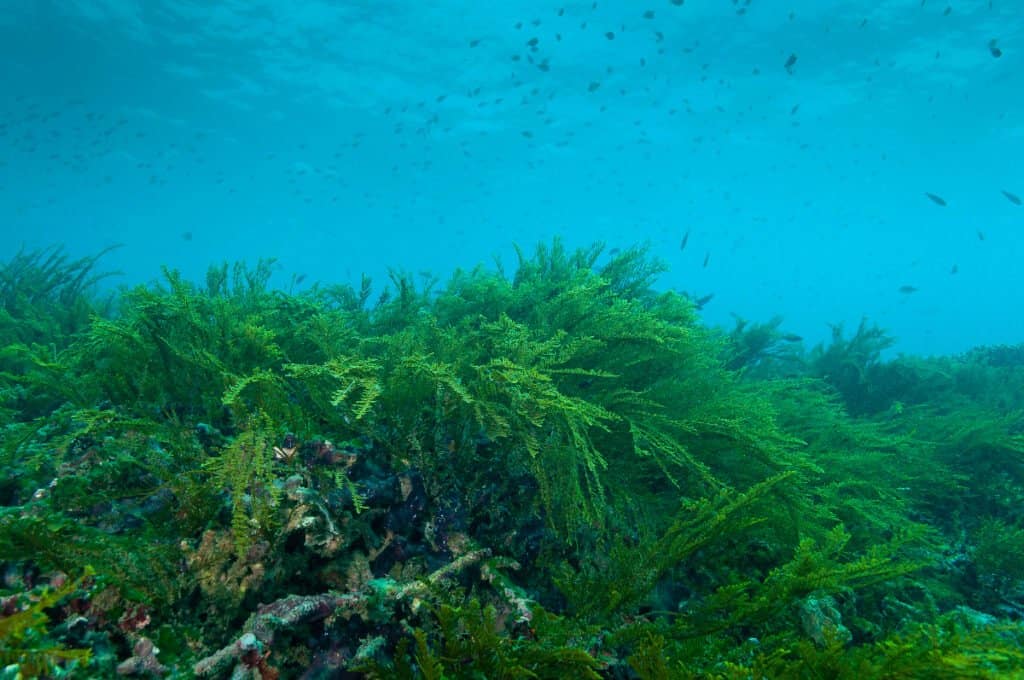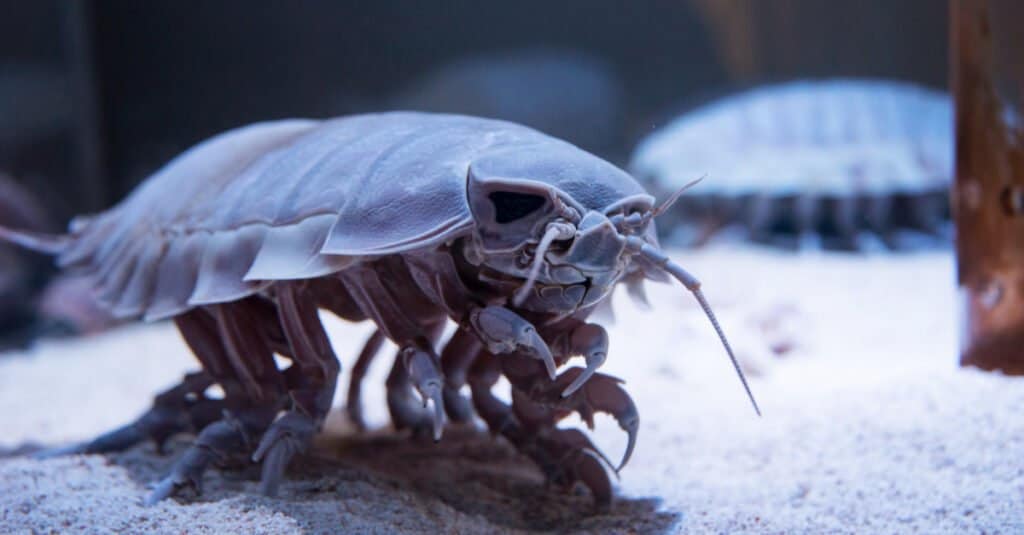Isopods are essential to our planet’s ecosystem and although they are small, they are certainly mighty!
Detritivore isopods eat decomposing organic matter which includes fallen leaves, fruits, decaying plants, animal remains, and pretty much anything dead they can find.
Let’s take a closer look at these wonders of the recycling world to find out what isopods eat, what isopods can’t eat, and how they go about finding their food.
What Do Isopods Eat?
Isopods eat rotten wood, fallen leaves, moss, lichen, dead remains of plants and animal remains too! Isopods forage throughout the day and night and will eat any dead, organic matter they uncover.
Without isopods, nature’s cycle would falter and our planet would become overrun with detritus. Isopods number in their millions and they break down the dead material to make room for new life on the land and in the sea.
A Complete List Of Foods Isopods Eat
Isopods are the world’s clean-up crew so this list is endless, but here are the main foods isopods eat.
Leaf litter
Decaying wood
Decaying plant life
Any fruits
Any vegetables
Decaying eggs
Moss
Lichen
Fur or hair
Bones
Faeces
Isopods living in the ocean will eat the equivalent of a land isopod. Dead fish, whale faeces, and decaying sea plants are comparable ocean-borne foods.

Seaborne isopods eat decaying
fish
and seaweed.
©Jesus Cobaleda/Shutterstock.com
What Do Pet Isopods Eat?
Pet isopods, such as a woodlouse, eat the same diet as wild isopods. The main food for land-based pet isopods is a variety of leaf litter.
Leaf litter can include softwoods such as cork bark, cholla wood, or any softwood that quickly decomposes.
Alongside their main diet of leaf litter and dead wood, pet isopods eat supplemental foods.
Because they have an exoskeleton they need calcium. Calcium from eggshells is the most common way to feed isopods, but cuttlefish and dead insects are healthy choices too.
Alongside supplemental calcium, many keepers give their pet isopods dried fish food or yeast flakes for protein.
What Is An Isopod’s Favorite Food?
Keepers and experts say it’s difficult to tell what an isopod’s favorite food is, but softwood and leaf litter are always eaten quickly. Because isopods eat anything that’s decayed it’s very hard to tell what they like the most.
How Much Does An Isopod Eat?
Not very much individually because isopods are very small, but a group will consistently clear rotting organic matter until it has disappeared.
A lot of food leads to a quick increase in the isopod population, so the more food there is the more isopods will make use of it.

A group of common woodlice will quickly eat decaying leaves.
A study in Oecologia showed that isopods ate more when presented with a variety of leaf litter compared to one type of leaf. It also highlighted the interesting fact that different types of isopods ate at different rates. Much like their food, the amount isopods eat is varied.
Are Isopods Dangerous To Humans?
People often wonder if isopods are dangerous to humans.
Because isopods eat dead and decomposing organic matter and don’t hunt, they are not dangerous. An isopod would not be capable of hurting you, even the giant isopods. A person is more likely to injure themselves by running away from one of these harmless creatures.
How Big Is A Giant Isopod?
If you’re now wondering about giant isopods, you’ll be pleased to hear they live in the ocean!
Giant isopods are an example of ocean gigantism. They grow larger compared to the rest of the species because they need to carry more oxygen on the ocean floor where they scavenge for food. Another theory is that they have very few predators at such depths.
The giant Isopod Bathynomus giganeus can reach up to 30 centimeters in length which doesn’t sound large, but is much bigger than an average isopod such as a 1 centimeter pill bug!

Giant isopods live in the ocean and reach 30 centimetres in length!
©kikujungboy CC/Shutterstock.com
How Does An Isopod Find Its Food?
Isopods find their food by foraging the ground or seabed looking out for anything that’s decayed. Isopods are real opportunists and will eat almost anything dead they find including cardboard.
Their hard shells protect them from predators such as birds and insects and many can roll into a ball, also known as conglobation, to keep their softer underbellies covered. When threatened or competing for mates, isopods rear onto their back legs and wave their front legs!
Armed with this protection isopods can move around to find their next meal.
What Can’t Isopods Eat?
Isopods don’t eat anything living, except in very rare cases of ocean isopods attacking trawlers of trapped fish.
Wild isopods are opportunists that forage and eat what they find by chance, but in captivity isopod keepers recommend avoiding potatoes. This is because the carbon dioxide level of decomposing potato shoots is too high and can cause suffocation in a closed tank.
Some keepers also avoid freshly cut wood because the sap is sticky and traps tiny isopods. Food that contains traces of pesticides may also pose a problem, so it’s best to wash down any store-bought fruit and veg.
If isopods are kept in a humid tank, it’s best not to add too many fresh fruits and vegetables as they quickly go moldy. Mold isn’t a problem for isopods who would simply eat it, but the smell isn’t pleasant or healthy for owners and other animals that share the terrarium.
How Long Do Isopods Live For?
Isopods live for one and half years on average. If their environment is dry, they will die earlier because moisture is very important to their survival. This is why they spent their time in damp leaf litter and decomposing moist wood.
Experts have noted that lone isopods tend to have a shorter lifespan which may indicate a reliance on social structures and group activities.
As nature’s garbage disposal units, isopods play an important part in our ecosystem. Isopods eat decaying organic matter, break it down into compost and create fertilizer for new plants.
Next time you spot a stray rolly-polly in your porch, usher it outside to some rotting wood, and be sure to say thank you for keeping our eco-system clean and oxygenized!
Up Next
- What Would Happen if Flies Went Extinct?
- What Do Rolly Pollies Eat?
- 9 Animals That Are Types of Decomposers
The photo featured at the top of this post is © iStock.com/Henrik_L
FAQs (Frequently Asked Questions)
What do isopods eat?
Detritivore isopods eat decomposing organic matter which includes fallen leaves, fruits, decaying plants, animal remains, and pretty much anything dead they can find.
What does an ocean isopod eat?
Isopods living in the ocean will eat the equivalent of a land isopod. Dead fish, whale faeces, and decaying sea plants are comparable ocean-borne foods.
Thank you for reading! Have some feedback for us? Contact the AZ Animals editorial team.






